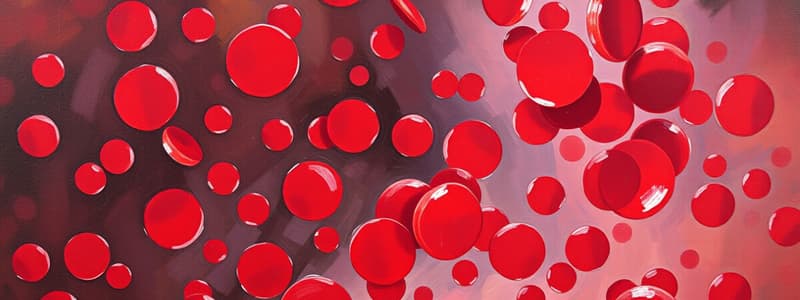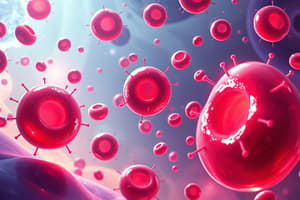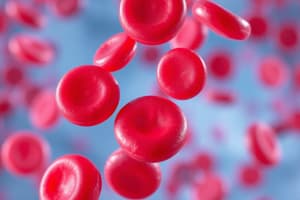Podcast
Questions and Answers
Which disorder is characterized by a deficiency of the glycoprotein complex Gplb-IX-V?
Which disorder is characterized by a deficiency of the glycoprotein complex Gplb-IX-V?
- Uremic platelet dysfunction
- Glanzmann thrombasthenia
- Bernard-Soulier syndrome (correct)
- Immune thrombocytopenia
What is a common laboratory finding in Immune thrombocytopenia?
What is a common laboratory finding in Immune thrombocytopenia?
- Increased platelet aggregation
- Normal Gplb levels
- Decreased platelet count (correct)
- Increased platelet clumping
In which disorder do uremic toxins interfere with platelet adhesion due to renal failure?
In which disorder do uremic toxins interfere with platelet adhesion due to renal failure?
- Glanzmann thrombasthenia
- Immune thrombocytopenia
- Uremic platelet dysfunction (correct)
- Bernard-Soulier syndrome
What is the primary cause of defective platelet plug formation in Glanzmann thrombasthenia?
What is the primary cause of defective platelet plug formation in Glanzmann thrombasthenia?
Which treatment is commonly used for refractory immune thrombocytopenia?
Which treatment is commonly used for refractory immune thrombocytopenia?
What is the primary defect in Glanzmann thrombasthenia?
What is the primary defect in Glanzmann thrombasthenia?
Which disorder is associated with normal bleeding time despite an increased platelet count?
Which disorder is associated with normal bleeding time despite an increased platelet count?
In Immune thrombocytopenia, what is the primary mechanism leading to low platelet counts?
In Immune thrombocytopenia, what is the primary mechanism leading to low platelet counts?
What characterizes the platelet count in Bernard-Soulier syndrome?
What characterizes the platelet count in Bernard-Soulier syndrome?
Which treatment is NOT typically used for Immune thrombocytopenia?
Which treatment is NOT typically used for Immune thrombocytopenia?
Which disorder is characterized primarily by impaired platelet adhesion due to a glycoprotein complex dysfunction?
Which disorder is characterized primarily by impaired platelet adhesion due to a glycoprotein complex dysfunction?
What is the primary cause of increased platelet destruction in immune thrombocytopenia?
What is the primary cause of increased platelet destruction in immune thrombocytopenia?
In which disorder would you expect to see increased megakaryocytes upon bone marrow analysis?
In which disorder would you expect to see increased megakaryocytes upon bone marrow analysis?
Which disorder is associated with a normal bleeding time despite having an increased platelet count?
Which disorder is associated with a normal bleeding time despite having an increased platelet count?
Which treatment option is typically considered for refractory cases of immune thrombocytopenia?
Which treatment option is typically considered for refractory cases of immune thrombocytopenia?
What best characterizes the platelet count in patients with Immune thrombocytopenia?
What best characterizes the platelet count in patients with Immune thrombocytopenia?
What is the primary defect observed in Glanzmann thrombasthenia?
What is the primary defect observed in Glanzmann thrombasthenia?
Which disorder is associated with increased megakaryocytes in bone marrow analysis?
Which disorder is associated with increased megakaryocytes in bone marrow analysis?
Which of the following disorders is characterized by impaired platelet adhesion?
Which of the following disorders is characterized by impaired platelet adhesion?
What type of treatment is commonly used for refractory cases of Immune thrombocytopenia?
What type of treatment is commonly used for refractory cases of Immune thrombocytopenia?
Which disorder exhibits increased platelet counts but has a normal bleeding time?
Which disorder exhibits increased platelet counts but has a normal bleeding time?
In which disorder are anti-GpIIb/IIIa antibodies primarily involved?
In which disorder are anti-GpIIb/IIIa antibodies primarily involved?
What laboratory finding is associated with Bernard-Soulier syndrome?
What laboratory finding is associated with Bernard-Soulier syndrome?
What is the underlying cause of increased platelet count in Bernard-Soulier syndrome?
What is the underlying cause of increased platelet count in Bernard-Soulier syndrome?
Which condition is primarily caused by the destruction of platelets mediated by antibodies?
Which condition is primarily caused by the destruction of platelets mediated by antibodies?
In Glanzmann thrombasthenia, what is the primary defect affecting platelets?
In Glanzmann thrombasthenia, what is the primary defect affecting platelets?
Which disorder is associated with impaired platelet function due to renal failure?
Which disorder is associated with impaired platelet function due to renal failure?
What is a common laboratory finding in patients with Immune thrombocytopenia?
What is a common laboratory finding in patients with Immune thrombocytopenia?
Flashcards are hidden until you start studying
Study Notes
Platelet Disorders Overview
- Various disorders lead to platelet dysfunction and affect the bleeding time and platelet count.
Bernard-Soulier Syndrome
- Autosomal recessive disorder characterized by decreased bleeding time and increased platelet count.
- Caused by deficiency or dysfunction of glycoprotein complex Gplb-IX-V on the platelet membrane.
- Impairs binding of platelets to von Willebrand factor, crucial for adhesion to vessel walls.
- Laboratory findings reveal decreased platelet aggregation.
Glanzmann Thrombasthenia
- An autosomal recessive disorder with increased platelet count and no specified bleeding time.
- Results from decreased GpIIb/IIIa, an integrin essential for platelet-to-platelet aggregation.
- Defective platelet plug formation leading to bleeding complications.
- Blood smear shows absence of platelet clumping.
Immune Thrombocytopenia (ITP)
- Autoimmune disorder where antibodies target platelets for destruction, primarily in the spleen.
- Characterized by increased bleeding time and increased platelet count.
- Can be idiopathic or secondary to other conditions like systemic lupus erythematosus (SLE), viral infections, malignancies, or drug reactions.
- Bone marrow analysis shows increased megakaryocytes, while complete blood count indicates decreased platelet count.
- Treatments include glucocorticoids, intravenous immunoglobulin (IVIG), rituximab, thrombopoietin receptor agonists (such as eltrombopag and romiplostim), and splenectomy for refractory cases.
Uremic Platelet Dysfunction
- Associated with renal failure, where uremic toxins accumulate and disrupt platelet function.
- Leads to increased platelet count but impaired adhesion, contributing to bleeding issues.
Platelet Disorders Overview
-
Bernard-Soulier Syndrome
- Characterized by decreased bleeding time and increased platelet count.
- An autosomal recessive disorder affecting platelet adhesion due to dysfunction in the glycoprotein complex Gplb-IX-V.
- Impaired binding to von Willebrand factor (vWF), critical for platelet adhesion at injured vessel walls.
- Laboratory findings include decreased platelet aggregation.
-
Glanzmann Thrombasthenia
- Platelet count remains increased, but no bleeding time data is specified.
- An autosomal recessive condition resulting in defective platelet aggregation due to decreased GpIIb/IIIa integrin.
- Leads to impaired platelet-to-platelet aggregation and suboptimal platelet plug formation.
- Blood smears typically show the absence of platelet clumping.
-
Immune Thrombocytopenia (ITP)
- Presents with decreased bleeding time and increased platelet count.
- An autoimmune disorder where platelets are targeted for destruction primarily in the spleen.
- Mediated by antibodies against GpIIb/IIIa, leading to platelet destruction by macrophages.
- Causes can include idiopathic origins, secondary autoimmune disorders (like SLE), viral infections (HIV, HCV), malignancy (CLL), and drug reactions.
- Laboratory analysis reveals increased megakaryocytes in bone marrow and decreased platelet counts in CBC.
- Treatments include glucocorticoids, intravenous immunoglobulin (IVIG), rituximab, TPO receptor agonists (like eltrombopag, romiplostim), and splenectomy for refractory cases.
-
Uremic Platelet Dysfunction
- No bleeding time data; platelet count is increased.
- Occurs in patients with renal failure where uremic toxins disrupt platelet adhesion.
Platelet Disorders Overview
- Various disorders affect platelet function, leading to different symptoms and treatment strategies.
- Bleeding time (BT) and platelet count (PC) are critical metrics for diagnosis.
Bernard-Soulier Syndrome
- Inheritance: Autosomal recessive disorder.
- Bleeding Time: Decreased, indicating impaired platelet function.
- Platelet Count: Increased, due to ineffective platelet adhesion.
- Defect: Adhesion defect caused by deficiency or dysfunction of glycoprotein complex Gplb-IX-V.
- Mechanism: Reduced Gplb impairs binding to von Willebrand factor (vWF), essential for adhesion to damaged vessels.
- Laboratory Findings: Decreased platelet aggregation on tests.
Glanzmann Thrombasthenia
- Inheritance: Autosomal recessive disorder.
- Platelet Count: Increased, but functionality is compromised.
- Defect: Aggregation defect due to decreased GpIIb/IIIa (integrin αIIbβ3).
- Mechanism: Impaired platelet-to-platelet aggregation leading to defective platelet plug formation.
- Laboratory Findings: Blood smear shows no clumping of platelets.
Immune Thrombocytopenia (ITP)
- Nature: Autoimmune disorder leading to platelet destruction.
- Bleeding Time: Decreased, reflecting reduced platelet function.
- Platelet Count: Increased due to increased destruction rather than production.
- Mechanism: Anti-GpIIb/IIIa antibodies tag platelets for destruction by splenic macrophages.
- Causes: Idiopathic; secondary causes include systemic lupus erythematosus (SLE), viral infections (HIV, HCV), malignancies (chronic lymphocytic leukemia - CLL), and drug reactions.
- Laboratory Findings:
- Bone Marrow Analysis: Increased number of megakaryocytes.
- Complete Blood Count (CBC): Shows decreased platelet count.
- Treatment: Includes glucocorticoids, intravenous immunoglobulin (IVIG), rituximab, thrombopoietin receptor agonists (eltrombopag, romiplostim), and splenectomy for refractory cases.
Uremic Platelet Dysfunction
- Condition: Associated with renal failure.
- Mechanism: Accumulation of uremic toxins disrupts platelet adhesion.
- Platelet Count: Typically increased, but functionality is impaired due to toxic interference.
Platelet Disorders Overview
- Various platelet disorders exhibit characteristic bleeding times and platelet counts.
Bernard-Soulier Syndrome
- Bleeding time is decreased; platelet count is increased.
- An autosomal recessive disorder indicating a defect in platelet adhesion.
- Caused by deficiency or dysfunction of glycoprotein complex Gplb-IX-V on the platelet membrane.
- Impaired binding of platelets to von Willebrand factor (vWF) disrupts adhesion to damaged vessels.
- Laboratory findings include decreased platelet aggregation.
Glanzmann Thrombasthenia
- Bleeding time is not specified; platelet count is increased.
- An autosomal recessive disorder affecting platelet aggregation.
- Results from decreased GpIIb/IIIa (integrin αIIbβ3), leading to poor platelet-to-platelet aggregation.
- Defective formation of platelet plugs is a key complication.
- Blood smear shows no platelet clumping, highlighting the aggregation issue.
Immune Thrombocytopenia (ITP)
- Bleeding time is decreased; platelet count is increased.
- An autoimmune disorder where platelets are destroyed, mainly in the spleen.
- Mediated by anti-GpIIb/IIIa antibodies, tagging platelets for splenic macrophage destruction.
- Causes include idiopathic origins, secondary causes like autoimmune disorders (e.g., SLE), viral illnesses (e.g., HIV, HCV), malignancies (e.g., CLL), and drug reactions.
- Laboratory analysis shows increased megakaryocytes in bone marrow; CBC reveals decreased platelet count.
- Treatment options include glucocorticoids, IVIG, rituximab, thrombopoietin receptor agonists (e.g., eltrombopag, romiplostim), and splenectomy for refractory cases.
Uremic Platelet Dysfunction
- Bleeding time is not specified; platelet count is increased.
- Common in patients with renal failure.
- Accumulation of uremic toxins disrupts platelet adhesion, challenging the formation of effective platelet plugs.
Platelet Disorders Overview
- Disorders categorized by bleeding time and platelet count help diagnose underlying conditions.
Bernard-Soulier Syndrome
- Autosomal recessive disorder characterized by decreased bleeding time and increased platelet count.
- Caused by deficiency or dysfunction of glycoprotein complex Gplb-IX-V on the platelet membrane.
- Impairs binding of platelets to von Willebrand factor (vWF), crucial for adhesion to damaged vessels.
- Laboratory findings reveal decreased platelet aggregation.
Glanzmann Thrombasthenia
- An autosomal recessive disorder with increased platelet count but no noted bleeding time.
- Resulting from decreased GpIIb/IIIa, an integrin important for platelet-to-platelet aggregation.
- Leads to defective platelet plug formation.
- Blood smear analysis shows no platelet clumping.
Immune Thrombocytopenia (ITP)
- Autoimmune disorder noted for decreased bleeding time and increased platelet count.
- Occurs due to the destruction of platelets, mainly in the spleen via anti-GpIIb/IIIa antibodies.
- Possible causes include idiopathic origins, secondary autoimmune disorders (e.g., SLE), viral illnesses (e.g., HIV, HCV), malignancies (e.g., CLL), and drug reactions.
- Bone marrow analysis reveals increased megakaryocytes; complete blood count shows decreased platelet count.
- Treatment options include glucocorticoids, intravenous immunoglobulin (IVIG), rituximab, thrombopoietin receptor agonists (e.g., eltrombopag, romiplostim), and splenectomy for refractory cases.
Uremic Platelet Dysfunction
- Observed in patients experiencing renal failure.
- Uremic toxins accumulate, leading to interference with platelet adhesion.
- Results in an increased platelet count without a specified bleeding time.
Studying That Suits You
Use AI to generate personalized quizzes and flashcards to suit your learning preferences.




